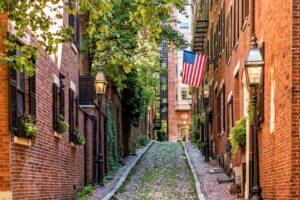Fodor's Expert Review Massachusetts State House
On July 4, 1795, the surviving fathers of the Revolution were on hand to enshrine the ideals of their new Commonwealth in a graceful seat of government designed by Charles Bulfinch. Governor Samuel Adams and Paul Revere laid the cornerstone; Revere would later roll the copper sheathing for the dome.
Bulfinch's neoclassical design is poised between Georgian and Federal; its finest features are the delicate Corinthian columns of the portico, the graceful pediment and window arches, and the vast yet visually weightless golden dome (gilded in 1874 and again in 1997). During World War II, the dome was painted gray so that it would not reflect moonlight during blackouts and thereby offer a target to anticipated Axis bombers. It's capped with a pinecone, a symbol of the importance of pinewood, which was integral to the construction of Boston's early houses and churches; it also serves as a reminder of the state's early connection to Maine, once part of Massachusetts.
Inside the... READ MORE
On July 4, 1795, the surviving fathers of the Revolution were on hand to enshrine the ideals of their new Commonwealth in a graceful seat of government designed by Charles Bulfinch. Governor Samuel Adams and Paul Revere laid the cornerstone; Revere would later roll the copper sheathing for the dome.
Bulfinch's neoclassical design is poised between Georgian and Federal; its finest features are the delicate Corinthian columns of the portico, the graceful pediment and window arches, and the vast yet visually weightless golden dome (gilded in 1874 and again in 1997). During World War II, the dome was painted gray so that it would not reflect moonlight during blackouts and thereby offer a target to anticipated Axis bombers. It's capped with a pinecone, a symbol of the importance of pinewood, which was integral to the construction of Boston's early houses and churches; it also serves as a reminder of the state's early connection to Maine, once part of Massachusetts.
Inside the building are Doric Hall, with its statuary and portraits; the Hall of Flags, where an exhibit shows the battle flags from all the wars in which Massachusetts regiments have participated; the Great Hall, an open space used for state functions that houses 351 flags from the cities and towns of Massachusetts; the governor's office; and the chambers of the House and Senate. The Great Hall contains a giant, modernistic clock designed by New York artist R. M. Fischer. Its installation in 1986 at a cost of $100,000 was roundly slammed as a symbol of legislative extravagance. There's also a wealth of statuary, including figures of Horace Mann, Daniel Webster, and a youthful-looking President John F. Kennedy in full stride. Just outside Doric Hall is Hear Us, a series of six bronze busts honoring the contributions of women to public life in Massachusetts. But perhaps the best-known piece of artwork in the building is the carved wooden Sacred Cod, mounted in the Old State House in 1784 as a symbol of the Commonwealth's maritime wealth. It was moved, with much fanfare, to Bulfinch's structure in 1798. By 1895, when it was hung in the new House chambers, the representatives had begun to consider the Cod their unofficial mascot—so much so that when Harvard Lampoon wags "codnapped" it in 1933, the House refused to meet in session until the fish was returned, three days later. Free guided tours are available; call for reservations. This is Freedom Trail stop 2.
READ LESS






